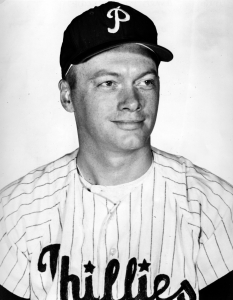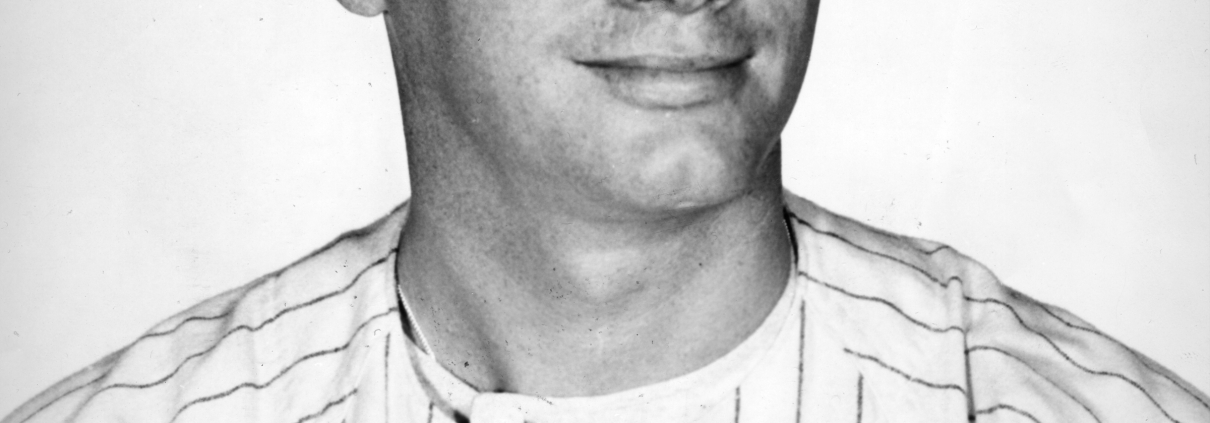June 7, 1966: Jim Bunning wins eighth straight with 14-strikeout, 3-hit gem
 “This was the best I’ve put all my pitches together this season,” said Jim Bunning of his overpowering victory over the Cincinnati Reds.1 In what Philadelphia Phillies beat writer Allen Lewis described as a “dandy display of power pitching,” Bunning matched his personal high with 14 strikeouts to win his eighth straight decision, equaling his career-best mark during the club’s memorable 1964 pennant race.2
“This was the best I’ve put all my pitches together this season,” said Jim Bunning of his overpowering victory over the Cincinnati Reds.1 In what Philadelphia Phillies beat writer Allen Lewis described as a “dandy display of power pitching,” Bunning matched his personal high with 14 strikeouts to win his eighth straight decision, equaling his career-best mark during the club’s memorable 1964 pennant race.2
The matchup in the City of Brotherly Love featured teams going in the opposite direction. Feisty skipper Gene Mauch’s Phillies had won seven of their last eight games to move to 28-21, in fourth place, 3½ games behind the San Francisco Giants. Their opponent for the first game of a three-game tilt as part of a season-long 16-game homestand was the Reds, who had lost 10 of 15 games to drop to 21-25 and sixth place.
One of the reasons for the Phillies’ hot start was their 34-year-old right-handed workhorse, Jim Bunning. Acquired in a trade with the Detroit Tigers in December 1963, Bunning had won 19 games in 1964 and 1965 to push his career slate to 156-104 beginning his 12th season. Given his advanced age and hoping to avoid a slump like the one in the previous year when his ERA hovered around 4.00 for the first six weeks of the season, Bunning asked to pitch more during spring training, and Mauch gladly obliged. “He’s a fiercely proud man as I’ve ever known,” said Mauch. “Everything about Jim Bunning is order. … He never makes a move without thinking about it.”3 The Cincinnati native, who attended that city’s Xavier University, entered the game with a stellar 7-1 slate and a 1.66 ERA.
Toeing the rubber for first-year skipper Don Heffner’s Reds was Milt Pappas, whose name will be forever linked to one of the most notorious trades in club history. In the offseason, the Reds sent a supposedly over-the-hill 30-year-old former MVP, Frank Robinson, to the Baltimore Orioles in exchange for the crafty right-handed, two-time All-Star with a 110-74 career slate. While fan favorite Robinson subsequently led the Orioles to the World Series title in ’66, Papas was coming off a strong campaign in ’65 (13-9, tied for fifth-lowest ERA in the AL at 2.60), but got off to a rocky start (4-3, 3.88) with his new team.
The Tuesday evening game with an 8:06 start time drew 12,422 spectators to venerable Connie Mack Stadium, located at 21st Street and Lehigh Avenue on Philadelphia’s north side. Baseball’s first steel and concrete ballpark was in its 57th year and had been gradually deteriorating for a decade; however, its ornate corner tower and exterior harked back to ballpark’s origins.
It was a “weird first inning,” quipped sportswriter Bill Conlin in the Philadelphia Daily News.4 Tommy Harper sent Bunning’s first pitch to deep left field, where Dick Allen dropped it for a two-base error. Unperturbed by the miscue, Bunning left Harper stranded on the keystone sack, retiring the next three batters, the latter two by strikeout.
Allen’s miscue was nothing compared to what happened to Pappas. After Cookie Rojas lined to center, Johnny Callison sent a fly ball to deep left field. According to Conlin, the ball drifted over Deron Johnson’s outstretched glove, took one bounce, and caromed off the wall for a double.5 Allen, who entered the game as one of the hottest hitters in baseball, slashing 8/23/.347 while slugging .716, despite having missed three weeks with a leg injury, smashed the ball on a “half swing” off the left side of the scoreboard in left-center field for a triple, driving in Callison.6 Bill White followed with a another clout to center field, but it “appeared to be nothing more than a sacrifice fly,” thought Allen Lewis.7 On what “looked like an easy catch,” wrote Reds beat writer Lou Smith, center fielder Vada Pinson began waving his hands.8 He lost the ball in the haze and lights. The ball landed about 30 feet behind Pinson and rolled to the warning track.9 White scampered around the bases for an inside-the-park home run, his ninth round-tripper of the season, to give the Phillies a 3-0 lead. The first-inning outfield circuit was not yet over. Tony Gonzalez sent another fly to left field, where Johnson dropped it attempting to make a shoestring catch, reported Conlin.10 Papas retired Dick Groat and Tony Taylor to end the frame.
The Phillies’ three first-inning runs were more than they needed the way Bunning pitched. With his sweeping side-arm delivery, he breezed through the next three innings, yielding a bunt single to Johnson in the second, and fanned three more. In the fifth, Chico Cardenas connected for a one-out home run to deep left field to put the Reds on the board. The hottest player in the league, Cardenas “continued to be the punchless Reds’ one-man attack,” wrote Smith in the Cincinnati Enquirer. It was Cardenas’s sixth home run in his last four games and accounted for his ninth run batted in of the last 14 Reds tallies.11 In the sixth, Pinson blooped a single to shallow center for the Reds’ third and final hit.
After his rough first inning, Pappas settled down, allowing only three scattered singles and one walk one in the next five innings. With two outs in the seventh, former Red Cookie Rojas extended his hitting streak to 10 games by walloping his second home run of the season, to deep left field. Callison doubled to left and then scored on Allen’s hit to center. Pinson’s peg to second baseman Pete Rose erased Allen trying to stretch the hit into a double.
The “Reds were as harmless as a covey of quail before a hard-working Bunning,” retorted Lou Smith.12 Bunning fanned the side in the eighth as the dirt stain on his left thigh grew increasingly larger and more pronounced. “When I’m not getting dirt on my leg,” he said, “it means I’m not getting down enough on my follow through.”13 Coming off a career-high 268 strikeouts in 291 innings in ’65, Bunning possessed one of baseball’s best high heaters, along with Bob Gibson. And like Gibby, Bunning was prone to giving up home runs and lots of fly balls. In this contest, only two balls were hit in the infield: Johnson’s bunt and Pete Rose’s seventh-inning grounder to Rojas, which accounted for the only assist of the game to equal a major-league record set many times. The key to this game, said Bunning, was his slider, which he tossed with such force from his side-arm delivery that he often careened off the mound and to first base with his gloved hand touching the ground.14 “When [my slider is] going right, it resembles my fast ball until the last minute, then it moves,” said Bunning.15
In the years before pitch counts determined how long a pitcher would last, Bunning was concerned that his fatigue might affect his mechanics in the last frame. “When I came in [to the dugout] after striking out those three hitters in the eighth,” he disclosed, “I told Gene I was tired and that he better watch me pretty close in the ninth.”16 Tommy Helms led off the ninth by flying out to left. “[He] did me a favor by hitting the first pitch,” said Bunning, “and that gave me a lift.”17 Bunning fanned Pinson to rack up his 14th strikeout, matching his career high achieved with the Tigers in 1958. It also tied Chris Short (1963) for the second most by a Phillies pitcher in a nine-inning game, though well off Art Mahaffey’s record-setting 17-strikeout performance in 1961. (Short fanned 18 in a 15-inning game on October 2, 1965.) Bunning dispatched Gordy Coleman on yet another outfield fly to end the game in 2 hours and 15 minutes.
Bunning’s three-hit gem with no walks was arguably the best game he tossed in a Phillies uniform in his four-year stretch (1964-1967) with the team, during which he averaged 19 wins, 298 innings pitched, and 248 strikeouts, while tossing 23 shutouts. En route to his ninth and final All-Star berth in 1966, Bunning concluded the season by winning 19 games for the third straight season (14 losses), leading the league with 41 starts and 5 shutouts, and setting a personal best with 314 innings pitched.
After pitching for the Pirates and Dodgers from 1968 to 1970, Bunning returned to the Phillies for his final two of 17 big-league seasons (1955-1971), retiring with a 224-184 career slate. He was inducted into the baseball Hall of Fame by the Veterans Committee in 1996. By that time, Bunning was an established Republican politician in the state of Kentucky. He served six terms in the House of Representatives (1987-1999) and two terms in the United States Senate (1999-2011).
SOURCES
In addition to the sources cited in the Notes, the author accessed Retrosheet.org, Baseball-Reference.com, SABR.org, and The Sporting News archive via Paper of Record.
NOTES
1 Bill Conlin, “Muddy Bunning Soils Reds with 3-Hitter, Fans 14,” Philadelphia Daily News, June 8, 1966: 49.
2 Allen Lewis, “Phils Roll, 5-1, Behind Bunning’s 3-Hitter,” Philadelphia Inquirer, June 8, 1966: 45.
3 Bill Conlin, “Muddy Bunning Soils Reds with 3-Hitter, Fans 14.”
4 Bill Conlin, “Outfielders Played It by Ear,” Philadelphia Daily News, June 8, 1966: 49.
5 Bill Conlin, “Outfielders Played It by Ear.”
6 Bill Conlin, “Outfielders Played It by Ear.”
7 Allen Lewis, “Phils Roll, 5-1, Behind Bunning’s 3-Hitter.”
8 Lou Smith, “Bunning Baffles Reds on 3 Hits, 5-1,” Cincinnati Enquirer, June 8, 1966: 41.
9 Bill Conlin, “Outfielders Played It by Ear.”
10 Bill Conlin, “Outfielders Played It by Ear.”
11 Smith.
12 Smith.
13 Bill Conlin, “Muddy Bunning Soils Reds with 3-Hitter, Fans 14.”
14 Frank Dolson, “Jim Bunning: Baseball and Beyond,” quoted in Bill James and Rob Neyer, The Neyer/ James Guide to Pitchers (New York: Fireside, 2004), 150.
15 Bill Conlin, “Muddy Bunning Soils Reds with 3-Hitter, Fans 14,”
16 Allen Lewis, “Bunning Tires in 9th, Gets ‘First Pitch’ Life,” Philadelphia Inquirer, June 8, 1966: 45.
17 Allen Lewis, “Bunning Tires in 9th.”
Additional Stats
Philadelphia Phillies 5
Cincinnati Reds 1
Connie Mack Stadium
Philadelphia, PA
Box Score + PBP:
Corrections? Additions?
If you can help us improve this game story, contact us.


